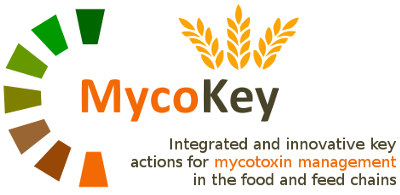Mycotoxins
Mycotoxins are secondary metabolites produced by fungi that are toxic to humans and animals consuming the products.
The mycotoxins represent one of the most important and sensitive problem for our world and our life, as various many products we normally use in our diet are exposed to their contamination.
Mycotoxins are dangerous for feed and food chains as they can create contamination in pre- and post-harvest processes. Mycotoxin research is making strong efforts to improve knowledge and reduction of aflatoxins, trichothecenes (deoxynivalenol, nivalenol, T-2 and HT-2 toxins, etc.) , zearalenone, fumonisins and ochratoxin A are very important to handle this problem.
Mycotoxin reduction targets of vital importance have been identified by some international food organizations (e.g. FAO, CIMMYT, EFSA, IITA, SAFE consortium), EU reports and relevant food industry representatives.
Mycotoxins effects
- Aflatoxin B1 is a proven carcinogen for humans. It is immunotoxic and causes stunted growth in children and growth retardation in animals.
- Fusarium toxins, especially fumonisins , are neurotoxic and possible carcinogens, trichothecenes are immunotoxic and zearalenone is estrogenic.
- Ochratoxin A is a nephrotoxin, possibly carcinogenic to humans and associated with Balkan Endemic Nephropathy.
Mixtures of mycotoxins probably have at least an additive, if not synergistic, egregious effects. These toxins are primary sources of both yield losses and increase of management costs worldwide .
Main food chains affected by mycotoxins
WHEAT and MAIZE
Wheat and maize have major mycotoxin safety concerns worldwide. The research on wheat has been much more intensive, while Maize is being treated from a toxicologically point of view as as wheat too.
Although in Europe there are no data on the economic costs of mycotoxins, for only Hungary the direct and indirect losses were estimated in a wheat epidemic (1998) to 100 million Euro. In the United States alone, the mean economic annual costs of farmer gate cereal crop losses due to aflatoxins, fumonisins and trichothecenes, are estimated to be $ 932 million.
GRAPE and WINE
Ochratoxin A addresses expecially raisin and sultanas and the grape-wine chain. Grapes and their processed products are very important in Europe where about 47% of worlds vineyards (4.8 million of ha) are found and 75% of the world’s wine (190 millions of hL is produced). Data on the economic impact of ochratoxin A in grapes and wine are not available or are not in the public domain because their release could cause a collapse in the wine market, which is a high value product but not considered as essential.
DRIED FRUITS and NUTS
Dried fruits and nuts present high risk for aflatoxin contamination, with high social and economic impacts resulting from stringent EU limits. A study carried out by the JECFA/WHO (Codex Alimentarius Commission, April 2007, CX/CF 071/9) estimated that the effect of applying to “ready-to-eat” almonds, hazelnuts and pistachios the EU limits for aflatoxins (4 ppb) has an economic impact on rejection of about 9 million Euros worldwide.



